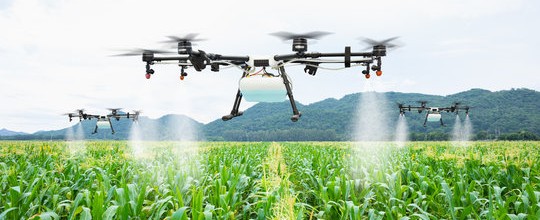Drones in Agriculture
How drones are helping Indian farmers improve crop yield and reduce costs.

Introduction
Agriculture remains central to India’s economy, yet many farms still rely on traditional practices that limit productivity. In this context, drones — also called unmanned aerial vehicles (UAVs) — are emerging as a practical, scalable way to modernize farming. From high-resolution crop monitoring to precision spraying and soil analysis, drones help farmers make faster, data-driven decisions while reducing costs and environmental impact.
Why Indian Agriculture Needs Drones
Indian agriculture faces several structural challenges: fragmented land holdings, periodic labor shortages, inefficient input use, and increasing climate variability. Drones address these issues by enabling precision agriculture — optimizing water, fertiliser and pesticide usage by targeting exactly where and when it's needed. This approach reduces waste, increases yields, and improves farmer incomes.
Key Applications
1. Crop Monitoring & Health Assessment
Drones equipped with RGB, multispectral and thermal sensors capture high-resolution imagery that reveals early signs of stress, nutrient deficiencies, pest infestations, or irregular irrigation. When processed with analytics tools, these images help pinpoint problem zones so farmers can act quickly — often saving a season’s yield.
2. Precision Pesticide & Fertilizer Spraying
Agricultural drones perform aerial spraying more evenly and efficiently than manual methods. They cover large areas quicker, reduce chemical consumption, and protect farm workers from direct exposure. For hilly or marshy areas where ground equipment struggles, drones are especially valuable.
3. Soil & Field Analysis
Using 3D mapping and NDVI (Normalized Difference Vegetation Index) maps from drone imagery, agronomists and farmers can assess soil variability, plan field layout, and tailor inputs per zone rather than blanket-applying treatments. This zonal approach increases yield potential and reduces costs.
4. Irrigation Management
Thermal imagery from drones highlights dry spots and inefficient irrigation zones. By guiding irrigation schedules and detecting leaks or blocked channels, drones help conserve water — a critical resource for sustainable farming.
5. Crop Insurance & Yield Estimation
Insurers and agribusinesses use drone data to produce tamper-proof, geotagged evidence of crop damage and more accurate yield projections. This speeds up claims and improves trust between farmers and insurers.
6. Livestock & Pasture Management
Drones also assist in monitoring pasture health and tracking livestock across large properties, enabling faster response to animal health or security issues.
Benefits for Farmers
- Increased efficiency: Faster monitoring and spraying across large and difficult terrains.
- Lower input costs: Reduced fertiliser and pesticide usage through targeted application.
- Safer operations: Less human exposure to agrochemicals.
- Better decision-making: Timely data leads to proactive interventions.
- Environmental gains: Lower runoff and reduced chemical load in soil and water.
Government Support & Schemes
The Indian government has promoted drone adoption via schemes and capacity-building initiatives. Subsidies and Drone as a Service (DaaS) models through custom hiring centres (CHCs) allow smallholders to access drone services without heavy upfront investment. Regulatory simplifications under DGCA and Kisan Drone initiatives are also making operations easier for agri-focused UAVs.
Challenges to Wider Adoption
Despite clear benefits, adoption faces a few hurdles:
- Cost: Good agricultural drones still require significant investment. Subsidies and DaaS help, but cost remains a barrier for many.
- Skills: Operators need training in piloting, maintenance, and data interpretation.
- Battery & Range Limits: Typical flight times are 20–40 minutes; larger scale use requires logistics for charging or swapping batteries.
- Weather sensitivity: Heavy wind and rain hamper operations.
Startups & Innovation
Indian startups are developing solutions tailored to local farms — from robust spray drones to analytics platforms that translate images into actionable agronomic recommendations. These ventures are lowering costs, improving reliability and helping scale services through partnerships with cooperatives and CHCs.
Future Outlook
Going forward, expect tighter integration of drones with AI, IoT and satellite data. AI models will predict disease outbreaks; swarm drones may cover large tracts collaboratively; and 5G connectivity will enable richer real-time telemetry. As costs fall and infrastructure matures, drones could become as standard on farms as tractors are today.
Conclusion
Drones are a transformative tool for Indian agriculture — boosting yields, cutting costs, and enabling sustainable practices. With the right policy support, training programs, and business models (like DaaS), drones can help farmers across India transition to precision agriculture and build resilient, more productive farms.


Comments (3)
Great article! The section about performance optimization was particularly helpful for my current project.
Thanks for sharing these insights. Would love to see a follow-up article with more advanced techniques.